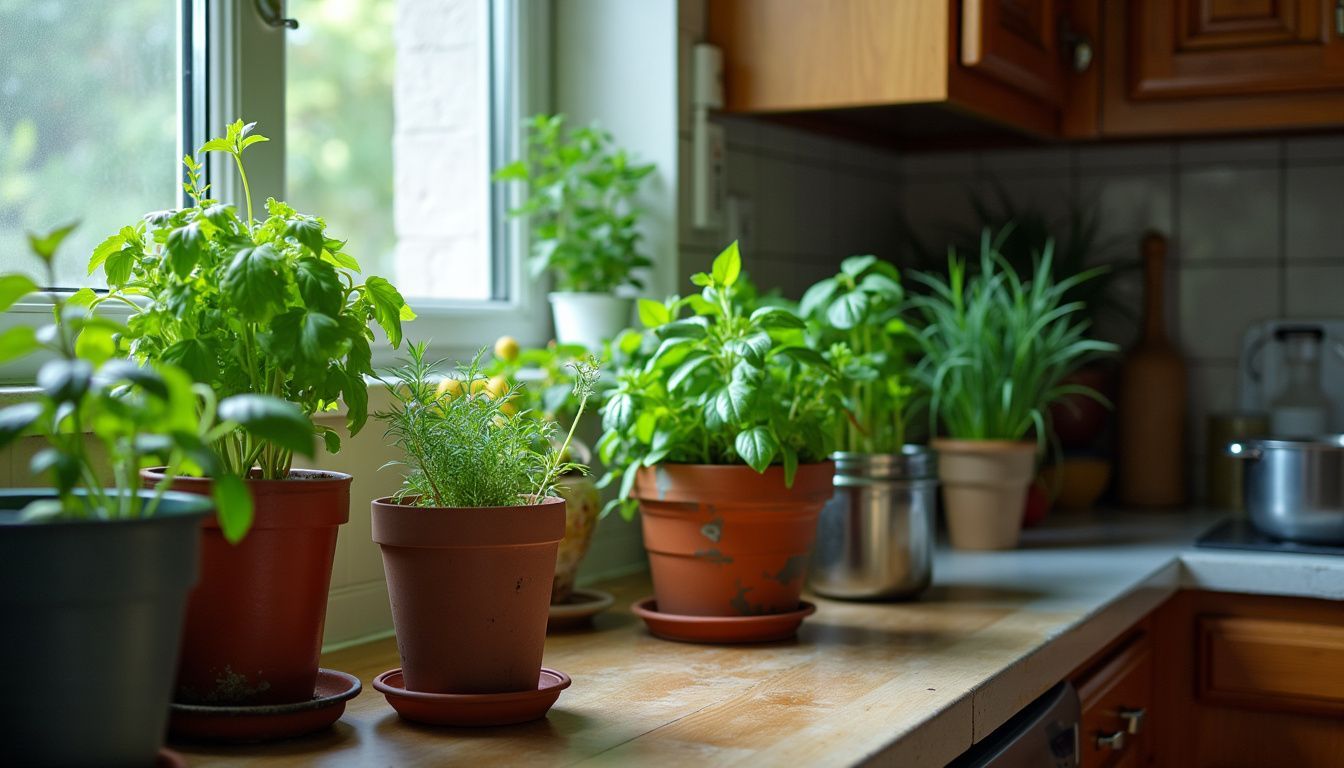Growing a herb garden in your kitchen brings fresh flavors right to your fingertips. This guide shows you how to start one. You need a sunny spot or a grow light, as herbs love 6 to 8 hours of sunlight daily.
Picking herbs you often use makes the garden both practical and rewarding. Basics like basil, parsley, and cilantro are good starts. Keeping these plants healthy involves regular trimming above leaf nodes for new growth and watering when the soil dries out.
Herbs thrive best at humidity levels between 40% to 60%, so keep an air humidifier handy or mist them regularly. Eventually, you’ll need to repot them for more space and harvest their leaves for cooking.
Let’s get growing!
How to Choose the Right Location for Your Kitchen Herb Garden
To grow a thriving kitchen herb garden, find a spot with plenty of sunlight. If natural light is limited, set up grow lights to help your herbs flourish.
Consider natural light
Natural light plays a vital role in growing herbs indoors. Most herbs thrive on six to eight hours of sunlight daily. Place your herb garden near a sunny window. South-facing windows work best.
If your kitchen lacks natural light, use a grow light setup. These lights can help you achieve the right conditions for herb plants.
Monitor your herbs closely. If they stretch towards the light, they need more. Conversely, if they burn or turn yellow, they may get too much sunlight. Ensure your herb garden setup allows for proper light exposure.
This simple step can lead to a thriving indoor garden.
Use a grow light setup
A grow light setup can significantly improve your kitchen herb garden. Many indoor spaces lack sufficient natural light. Grow lights provide the brightness that herbs need to thrive.
Select full-spectrum LED lights for the best results. Position the lights about 6 to 12 inches above the plants. This distance ensures that herbs receive adequate light without burning.
Set a timer for about 12 to 16 hours of light each day. This mimics natural sunlight, promoting healthy growth.
Monitor your herbs regularly. Adjust the height of the lights if you notice stretching. A grow light setup enhances your indoor gardening efforts. With the right care, your window herb garden will flourish.
Use it to grow basil, cilantro, parsley, and more. Choosing the right herbs will make your kitchen lively and flavorful.
Tips for Growing a Successful Kitchen Herb Garden
Growing a kitchen herb garden can be fun and rewarding. Choose herbs that you enjoy cooking with, and keep them healthy by providing proper care.
Choose herbs that you eat regularly
Select herbs that you enjoy using in your meals. This choice makes your kitchen gardening more rewarding. Basil, parsley, and cilantro are popular options. These herbs add flavor to salads, sauces, and main dishes.
Check your spice cabinet. If you often reach for certain herbs, grow them in your home herb garden.
Focus on herbs that are versatile. You can use them in various recipes. Regularly pruning and harvesting will keep them fresh and encourage growth. Use a herb garden planter or a window herb garden kit to make the most of your space.
Your kitchen will thrive with fresh, edible plants at your fingertips.
Know how to trim and prune
After choosing herbs that you eat regularly, focus on trimming and pruning them. This practice encourages healthy growth and keeps your kitchen herb garden vibrant. Use sharp scissors or pruning shears to cut stems.
Trim just above a leaf node to promote new growth.
Regular pruning also helps prevent overcrowding in your herb planter. Remove any dead or yellowing leaves to maintain plant health. Be sure to trim herbs like basil and mint often.
These herbs respond well to pruning and will offer more flavorful leaves. Proper watering and feeding support this growth, ensuring your herbs thrive in container gardening.
Properly water and feed your herbs
Herbs thrive with proper watering and feeding. Water your herbs when the soil feels dry to the touch. Overwatering can drown the roots and harm the plants. Use a balanced fertilizer every four to six weeks.
This feeding helps herbs grow strong and healthy.
Humidity plays a key role in their growth. Most herbs prefer a humidity level of 40-60%. Mist your plants or use a humidity tray if your kitchen is dry. Pay attention to the needs of each herb.
Adjust watering and feeding based on their growth. With these steps, your kitchen herb garden will flourish.
Optimize humidity levels
Proper watering and feeding your herbs leads to their overall health. To optimize humidity levels, consider your kitchen environment. Most herbs thrive in humidity between 40% and 60%.
Use a small humidifier if your space feels dry. Misting your plants with water can also help. Grouping herbs together creates a microclimate with higher humidity. Keep an eye on your herbs.
Adjust the humidity as needed to support their growth in your kitchen herb garden.
Harvest and repot when necessary
Harvest your herbs regularly. Cut the leaves just above a node. This encourages new growth. Use your fresh herbs in meals to enjoy their flavor.
Repot your herbs if they outgrow their containers. Check the roots. If they circle the pot, it’s time for a larger one. Choose a pot with good drainage. This helps prevent root rot.
Water your repotted herbs well. Proper care ensures a thriving herb garden in your kitchen.

